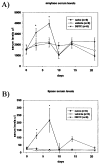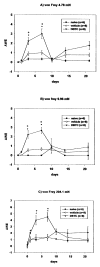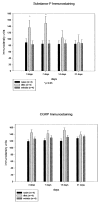Nociception in persistent pancreatitis in rats: effects of morphine and neuropeptide alterations
- PMID: 12552208
- PMCID: PMC4654116
- DOI: 10.1097/00000542-200302000-00029
Nociception in persistent pancreatitis in rats: effects of morphine and neuropeptide alterations
Abstract
Background: Most animal models of pancreatitis are short-lived or very invasive. A noninvasive animal model of pancreatitis developed in highly inbred rats by Merkord with symptoms persisting for 3 weeks was adopted in the current study to test its validity as a model of visceral pain in commercially available rats.
Methods: The persistent pancreatitis model was established by tail vein injection of dibutyltin dichloride. Animals were given 10% alcohol in their drinking water to enhance the pancreatitis attack. Blood serum pancreatic enzymes and nociceptive state were monitored for 3 weeks after dibutyltin dichloride or vehicle. Behavioral testing included reflexive withdrawal to mechanical and thermal stimulation of the abdominal area. The effect of morphine on nociceptive behaviors was tested. Histologic analysis of the pancreas and immunohistochemical analysis of substance P and calcitonin gene-related peptide in the spinal cord are included in the study.
Results: Compared with naïve and vehicle-only injected control groups, rats receiving dibutyltin dichloride demonstrated an increase in withdrawal events after von Frey stimulation and decreased withdrawal latency after thermal stimulation, signaling a sensitized nociceptive state through 7 days. These pain-related measures were abrogated by morphine. Blood serum concentrations of amylase and lipase as well as tissue inflammatory changes and substance P were also significantly elevated during this same time period.
Conclusions: These results indicate that animals with the dibutyltin dichloride-induced experimental pancreatitis expressed serum, histologic, and behavioral characteristics similar in duration to those present during acute attacks experienced by patients with chronic pancreatitis. These findings and responsivity to morphine suggest the utility of this model developed in a commercially available strain of rats for study of persistent visceral pain.
Figures







Comment in
-
Do we need another animal pain model?Anesthesiology. 2003 Feb;98(2):291. doi: 10.1097/00000542-200302000-00003. Anesthesiology. 2003. PMID: 12552183 No abstract available.
References
-
- Millan MJ. The induction of pain: An integrative review. Prog Neurol. 1999;57:1–164. - PubMed
-
- Cervero F. Sensory innervation of the viscera: Peripheral basis of visceral pain. Physiol Rev. 1994;74:95–138. - PubMed
-
- Merriam LT, Wilcockson D, Samuel I, Joehl RJ. Ligation-induced acute pancreatitis increases pancreatic and circulating trypsinogen activation peptides. J Surg Res. 1996;60:417–21. - PubMed
-
- Schmidt J, Compton CC, Rattner DW, Lewandrowski K, Warshaw AL. Late histopathological changes and healing in an improved rodent model of acute necrotizing pancreatitis. Digestion. 1995;56:246–52. - PubMed
-
- Gaeta L, Dionigi G, Dionigi R. Experimental models of acute pancreatitis. Chir Ital. 2000;52:469–97. - PubMed
Publication types
MeSH terms
Substances
Grants and funding
LinkOut - more resources
Full Text Sources
Other Literature Sources
Medical

